Anyone who’s ever watched a great movie has probably fantasized about writing their own Oscar-winning screenplay.
Yet, if you’re one of the few people inspired enough to take action, you’ve probably realized that a standard text editor won’t cut it.
Crafting a screenplay that meets film industry standards requires industry-standard screenwriting software.
For example, a feature like auto-formatting helps your creative process by letting you focus on what matters: your story.
In contrast, your run-of-the-mill word processor bogs you down with manual capitalization and spacing.
This article reveals nine of the best screenwriting software programs available today.
With one of these screenwriting tools, you’ll be all set to earn your first gold statue.
9 Best Screenwriting Software [Comparison Table Overview]
| Product | Free / Paid | Auto-complete and formatting | Collaboration Tools |
| Final Draft | Paid | Yes | Yes |
| Celtx | Paid | Yes | Yes |
| Movie Magic Screenwriter | Paid | Yes | Yes |
| Fade In | Paid | Yes | Yes |
| Trelby | Free | Yes | Yes |
| WriterDuet | Paid | Yes | Yes |
| Highland 2 | Paid | Yes | Yes |
| Arc Studio Pro | Paid | Yes | Yes |
| Scrivener | Paid | Yes | Yes |
9 Best Screenwriting Software For 2022
With the comparison done, let’s check out the best screenwriting software programs of 2022, which are as follows:
1. Final Draft

Final Draft is probably the most well-known screenwriting software program around.
The latest release of this industry-standard software (Final Draft 12) is packed with tons of advanced features.
Professional screenwriters and other entertainment industry professionals swear by this software, as you can use it for more than writing screenplays.
One way Final Draft transcends script-writing software is with its beat board.
This feature complements your writing process by providing a limitless space you can use to organize your ideas.
Think of it as a digital whiteboard you can post color-coded sticky notes on. Each note can store information about sets, characters, etc.
And you can connect them with flow lines.
Another impressive Final Draft feature is its ScriptNotes.
When using this screenwriting software, you can leave yourself little comments that appear as flags in your script.
This feature is essential for capturing ideas as they come to you and is what makes Final Draft one of the best screenwriting software tools.
Also, Final Draft has real-time collaboration tools for professionals who work with writing partners, a feature excellent for online collaboration.
And this professional screenwriting software records every change you make to your script.
Think a deleted line worked better than the one you’ve written?
Compare the changes by viewing your revision history.
If you’d rather not format documents from scratch, Final Draft provides a ton of templates—over 300 of them.
From graphic novels to teleplays, it gives professional writers the structure needed to jumpstart the creative process.
Meanwhile, its SmartType feature speeds up your workflow by auto-filling frequently-used character names, locations, and so on.
Additional Final Draft features worth mentioning include its PDF imports and image inserts.
You can import and convert a PDF into an editable Final Draft file with the former, while the latter lets you insert images into the title page, script pages, and beat board.
The above features and more put Final Draft high among the best screenwriting software programs.
Key Features
- The beat board provides an unlimited workspace for developing ideas
- Final Draft’s ScriptNotes feature lets you leave yourself comments on the script
- Over 300 templates to kick-start your creative process
- Can import and convert PDFs into editable text
Bottom Line
Final Draft is the leading screenwriting software in the film industry.
Consider getting it if you want to use what professional writers use.
2. Celtx

Although Celtx started out as a free screenwriting software, it has since evolved from its word-processing program roots into a multi-feature film industry project management tool.
Over the years, the software has kept its screenplay editor’s simple user interface but has been overhauled in other places.
One of Celtx’s tent-pole features is its auto-formatting.
With this functionality included, you can focus on crafting a compelling screenplay and leave the formatting to Celtx’s AI.
In addition, it makes formatting your script elements straightforward.
You can provide the cast and crew with clear stage direction, keeping everyone aligned with your creative vision.
Also, Celtx provides story development tools that keep your creative process organized.
You can store data about your story on index cards to ensure cohesion and continuity.
Meanwhile, if you’re working with a storyboard artist, Celtx’s storyboard feature will help them bring your text to life.
And its analytics feature provides valuable insights about your prose.
Celtx’s pre-production planning tools help film industry pros keep the pre-production process hitch-free.
For example, you can track vendor, cast, and crew changes and perform scheduling tasks.
And the cataloging functionality helps you organize information about a project’s assets (crew, equipment, wardrobe, locations, etc.) in one place.
Another factor that makes Celtx one of the best screenwriting software tools is its ability to create production-related documents.
This screenwriting software can create shot lists, sides, and call sheets that cast and crew members can rely on to stay in sync during shoots.
Also, Celtx produces budgets and production reports, letting you keep your project on track.
The software’s collaboration tools are similarly top-notch.
You can invite writing partners to read and edit your script or approve it using text-anchored comments.
In addition, this feature’s presence awareness function lets you see what a co-writer is working on, keeping your real-time collaborative writing session organized.
Key Features
- Story development tools improve your workflow by letting you store data about your story on index cards
- Its collaboration tools let you work with a co-writer on the same script simultaneously
- Can create shot lists, call sheets, and other film production documents
- The cataloging functionality allows for the organization of a project’s assets
Bottom Line
Celtx is worth considering if you have needs beyond screenwriting (for example, if you’re a writer/director).
3. Movie Magic Screenwriter
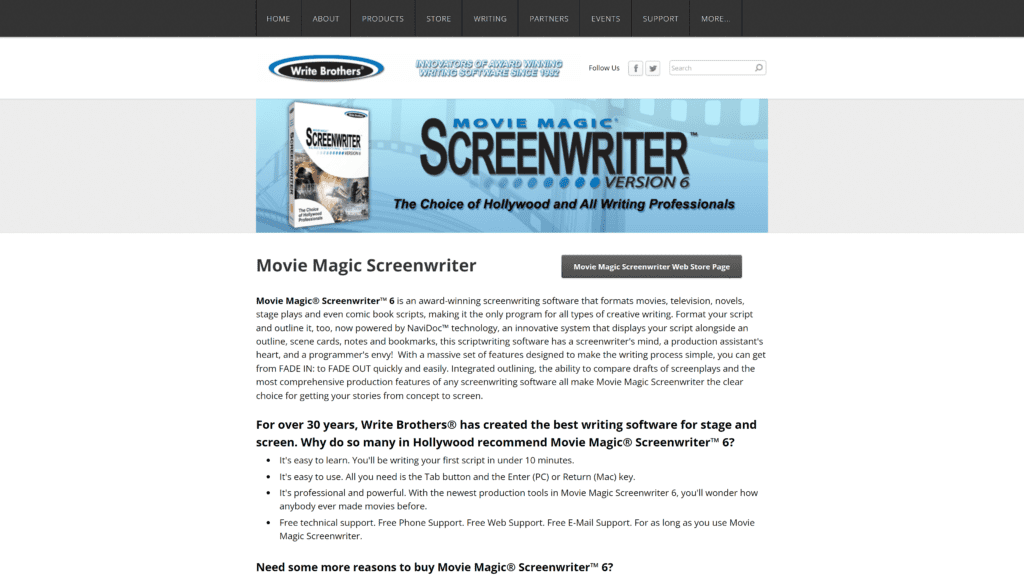
If you’re looking for an all-in-one solution for all forms of creative writing, Movie Magic Screenwriter is among the best screenwriting software programs for the job.
This screenwriting tool can help you write screenplays, comic scripts, novels, TV specs, and more.
And it’s an easy-to-learn screenwriting program, thanks to its intuitive interface.
In addition to its automatic script format function, Movie Magic Screenwriter makes outlining scripts easier.
It’s powered by NaviDoc™ technology, which provides a side-by-side display of your script and an outline, notes, bookmarks, or scene cards.
Meanwhile, one of its most basic features is a library of 100+ screenplay templates that speed up the screenwriting process.
Additionally, the latest version of Movie Magic Screenwriter has a text-to-speech engine.
This feature is used for developing character dialogue, as you can experiment with a character’s voice by hearing how they sound.
And if you’re lost for words at any point, the screenwriter’s built-in American English thesaurus can come to your rescue.
Movie Magic Screenwriter counts itself among screenwriting software options with an autosave feature.
Also, the software has a handy revision tracking feature that lets you track all versions of your manuscript.
It’s extremely useful for comparing or reverting changes as necessary.
Thanks to the software’s iPartner™ collaboration, multiple screenwriters can work on the same screenplay even when located miles apart.
And Movie Magic Screenwriter has production tracking technology film set project managers can use to keep track of the production.
For example, you can generate rundown sheets, sides, and set lists.
Windows and Mac Users will be impressed by how optimized this software is with the latest versions of both operating systems.
It means you get the latest features like exporting scripts into PDF and other file formats and access to its fully-editable index card view.
Key Features
- An intuitive user interface makes this software easy to learn
- NaviDoc™ technology provides a side-by-side view of your script and outline
- The text-to-speech engine lets you hear your characters’ dialogue
- A built-in American-English thesaurus provides synonyms when you’re lost for words
Bottom Line
Movie Magic Screenwriter is best for screenwriters who live and breathe their characters during the writing process.
If that’s you, you’ll love using its text-to-speech feature.
4. Fade In
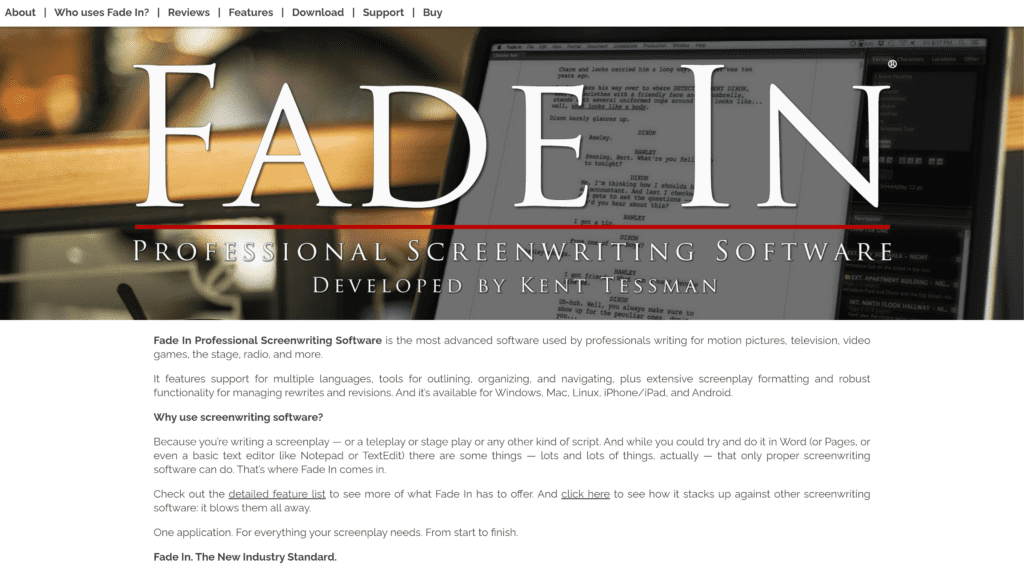
Fade In is a screenwriting software made by a scriptwriter (Kent Tessman) for scriptwriters.
This software features automatic formatting, works on multiple platforms, can import and export different file formats, and is user-friendly.
The software includes templates for a host of different standard screenplay styles.
You can customize each one or build yours from scratch.
And if you’re particular about details, you can edit page layouts down to the length of individual lines.
Fade In does pretty much anything a standard text processor can.
The software’s auto-complete feature is incredibly helpful in speeding up the writing process.
Fade In takes note of your frequently-used names and locations, serving them up as suggestions when you type the first letter.
Handily, you can customize, sort, or rebuild the suggestion lists to improve your workflow.
Additionally, Fade In has real-time collaboration functionality, letting multiple writers work on the same script simultaneously.
And unlike similar software, the collaboration isn’t turn-based, meaning document edits can happen concurrently and independently of each other.
, it supports image inserts, so visual thinkers can better visualize scenes.
When you need to rewrite dialogue, you can count on its built-in dialogue tuner.
This feature isolates a specific character’s dialogue in one place, providing an easy way to root out inconsistencies in their tone and speech patterns. Additionally, the feature helps you spot overused words so your dialogue appears more natural.
Other features that make Fade In worth considering include its ability to generate a script breakdown and production reports.
Also, this cloud-based software works on mobile devices and syncs changes.
Finally, all Fade In files are saved in an open file format, ensuring high compatibility with other software programs when exported.
Key Features
- A fully-customizable editor provides editing control down to individual line
- Image inserts let visual writers insert images into the page
- The built-in dialogue tuner helps fine-tune your dialogue
- Fade In’s compatibility with mobile devices lets you work from anywhere
Bottom Line
Fade In is made by a writer for writers.
If you’re looking for software created with you in mind, it doesn’t get any better than this.
5. Trelby
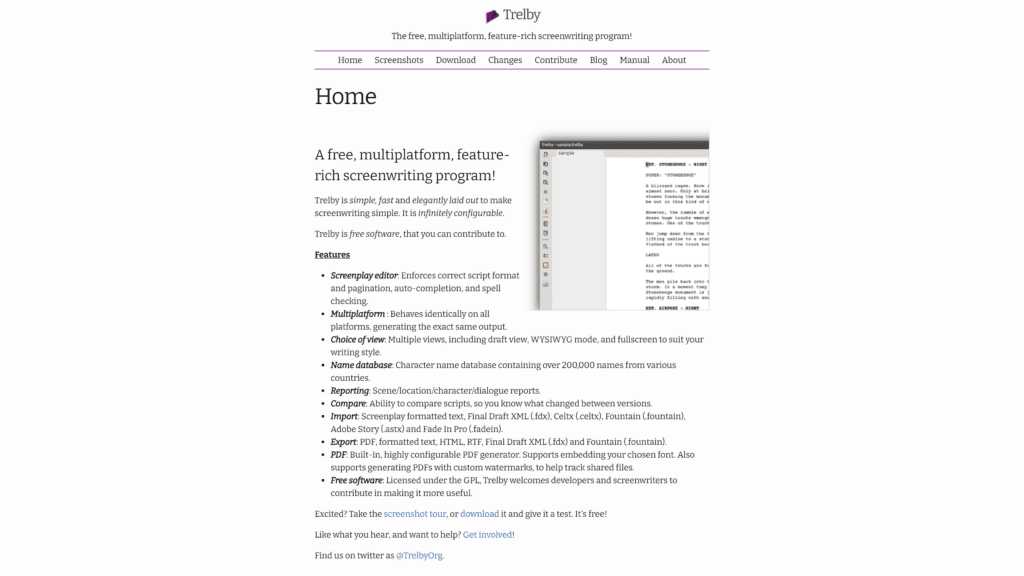
Trelby is the only open-source screenwriting software on our list.
It’s 100% free software you can improve upon if you have coding skills.
However, compared to the limited features you get when you sign up for the free version of paid software, Trelby provides a slew of features to aid your writing process for the big screen.
This software’s screenplay editor can format scripts automatically, saving you time, energy, and the headspace needed for creative thinking.
In addition, it has built-in spellcheck and auto-complete functionality and a pagination function.
And you can switch between multiple views, like distraction-free writing mode and fullscreen view.
One particularly helpful feature is Trelby’s character name database.
If you struggle with coming up with character names when script writing, you’ll appreciate the 200+ names in the database.
Helpfully, the names originate from different countries, so if you’re developing a non-English speaking character, Trelby has you covered.
It lets you import multiple file formats, including files from other software like Final Draft (.fdx), Fade In Pro (.fadein), and Celtx (.celtx).
Also, you can export your files in several file formats, such as PDF or HTML files.
And because Trelby is a multi-platform software, you can expect it to work the same way on all major software operating systems.
If you’ve ever worried about your script ending up in the wrong hands or being plagiarized, you’ll appreciate Trelby’s custom watermarks.
You can apply them when you export your file as a PDF, letting you track any files you share.
Finally, this software supports report generation.
You can stay organized by producing reports for dialogue, locations, scenes, characters, and so on.
As such, you can avoid embarrassing script inconsistencies while producing your best work.
Meanwhile, Trelby’s versioning capabilities let you compare scripts so you’re cognisant of changes made during the course of your writing.
Key Features
- Open-source and free-to-use
- Built-in spelling checker spots spelling errors you miss
- Can import multiple file formats (including Celtx and Fade In files)
- The custom watermarks prevent your exported PDF script from being plagiarized
Bottom Line
If you’re looking for free screenwriting software with amazing features, look no further than Trelby.
6. WriterDuet
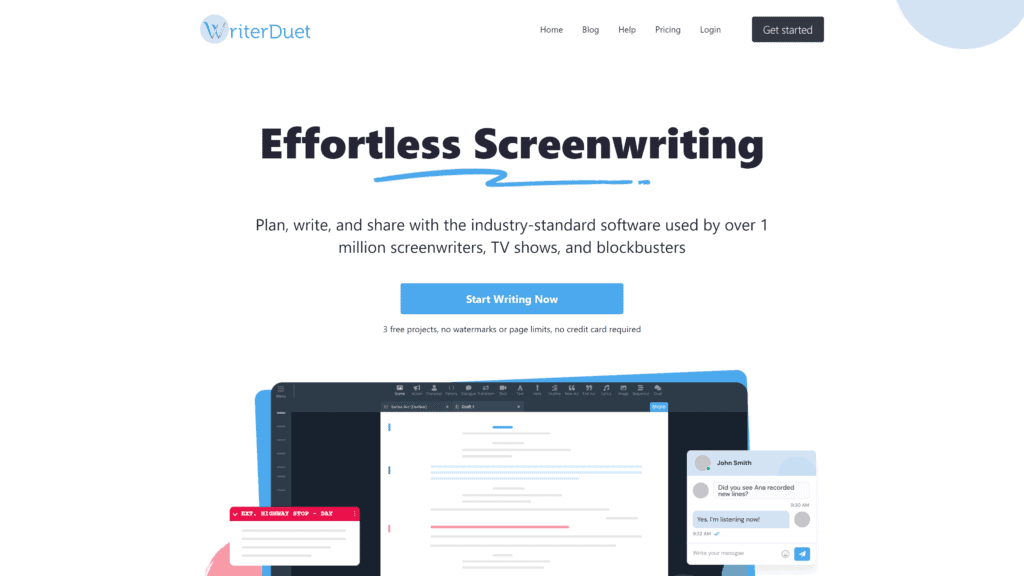
With collaboration tools like real-time co-writing, text and video chat, and commenting, you can be forgiven for assuming WriterDuet was so named because of the above-mentioned features.
This screenwriting software puts co-writing at the forefront of everything it can do, making it a fantastic choice for writing teams.
The free version lets you write three projects without watermarks or page limits. Its import feature is similarly impressive, as you can continue where you left off if you started writing in another software (e.g., one where the free trial period expired).
Meanwhile, upgrading to one of the premium versions unlocks amazing features beyond its industry-standard formatting and templates.
Key among the software’s premium features is its revisions management.
WriterDuet “remembers everything,” meaning it saves all versions of your script as you work.
Another impressive feature only available in the premium tier is WriterDuet’s script translation.
You can translate your finished script into multiple languages, which is an excellent feature for television writers.
You’ll want this feature if you dream about your project being syndicated around the world or remade for different markets.
WriterDuet’s autofill feature speeds up the writing process by populating your script with frequently-used character names and locations when you click on an entry in the suggestion box pop-up.
Its autosave feature provides the peace of mind needed to work freely.
And if you go offline for any reason, it’ll sync your edits once you’re back online.
Thanks to impressive technology, you can hear how your characters sound.
Using WriterDuet’s computer-generated voices, you can test dialogue, removing the guesswork of whether a line translates well off the page.
And when you’re done writing, WriterDuet can handle file exports in multiple formats (including PDF and Word documents).
Key Features
- Collaboration tools like video and chat enhance the virtual writers’ room experience
- Script translation functionality lets you write in multiple languages
- Computer-generated voices help you improve character dialogue
- The free version doesn’t impose page limits or a watermark
Bottom Line
WriterDuet is the screenwriting software to choose if you have big dreams of creating a hit TV show.
Its translation feature will further your syndication ambitions.
7. Highland 2
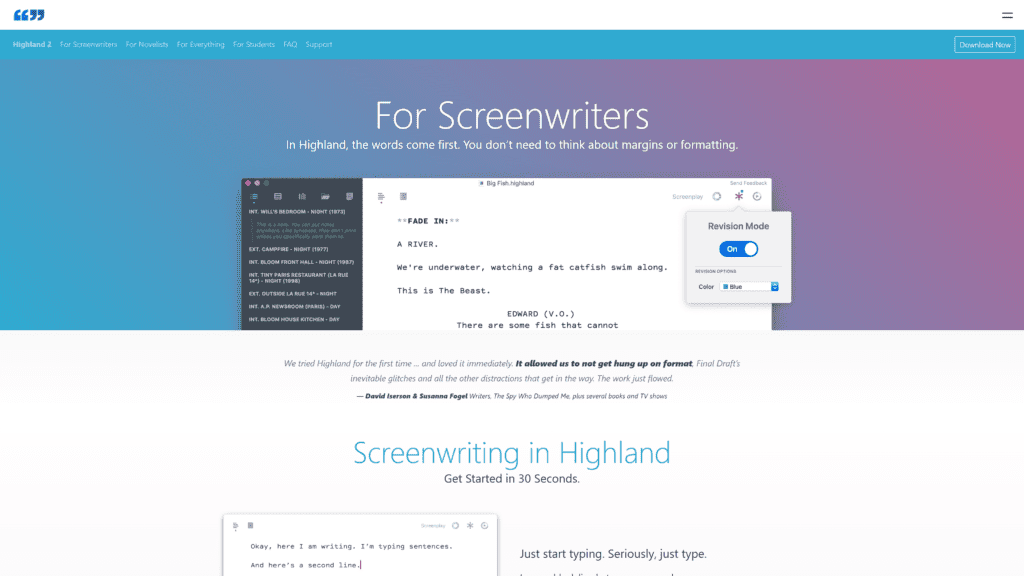
Highland 2 is one of the most straightforward screenwriting software programs available.
Thanks to its intelligent AI, you can start writing your screenplay in 30 seconds and watch it come to life with every keystroke.
When you type a character’s name in uppercase, Highland 2 automatically formats any text written under it as dialogue.
And if you turn on its live margins feature, the software will automatically indent your prose to meet industry standards.
This functionality speeds up your workflow, as hitting the enter button is all you need to do to move your story forward.
You only need to use a character or location name once before it’s stored in the Highland 2 database.
The program will recognize your intention to use these names repeatedly and suggest them the next time you type the first letter.
Highland 2 provides a handy bin the developers describe as a “magical shelf to hold bits of text you want to keep handy.”
This amazing feature lets you store alternate versions of your prose (dialogue, scenes, etc.) for later comparison.
And working with revision mode turned on lets you see your changes as colored text.
One of Highland 2’s most impressive features is the software’s aptitude for gender analysis.
In a nutshell, you can use this feature to break down how much dialogue you’ve apportioned to your male and female characters.
So if you’re particular about gender equality while writing, you’ll consider it to be a godsend.
Highland 2 can export scripts into PDFs and import scripts saved in PDF and Final Draft file formats.
In the latter case, the software will automatically convert the files into editable text, meaning you can edit that old script you forgot to save in an editable file format (like MS Word).
Key Features
- Lightning-fast setup lets you start writing in 30 seconds
- Highland 2’s bin feature lets you store alternative versions of dialogue and scenes
- The gender analysis tool encourages gender equality in your writing
- Live margins auto-indent your script as you type
Bottom Line
Highland 2 is an excellent choice for screenwriters who don’t want to spend too long learning software.
8. Arc Studio Pro
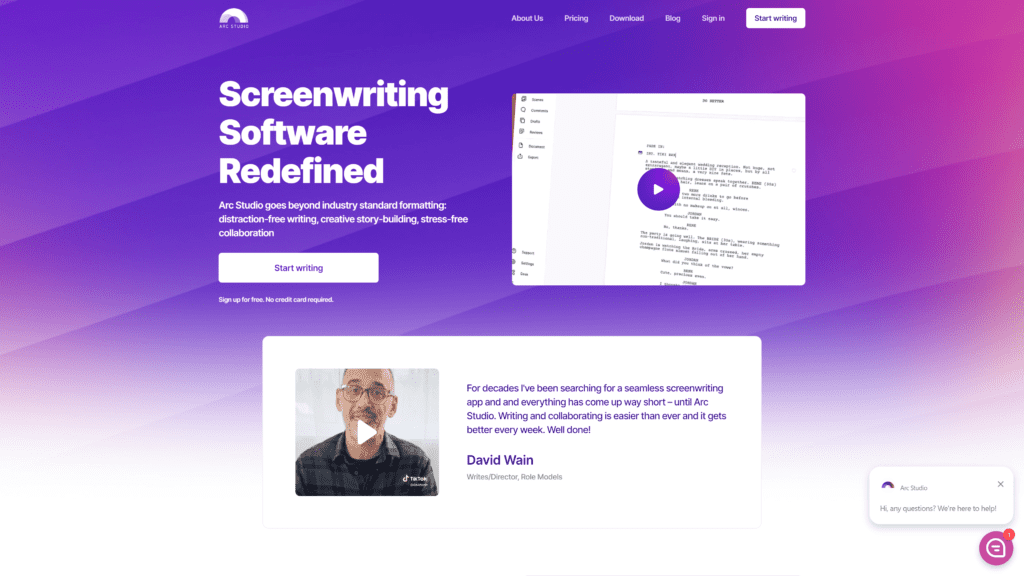
Arc Studio Pro is a multi-functional and feature-rich writing platform for anyone who’s serious about writing scripts.
This cloud-based software goes beyond script formatting by offering writers a slew of features that’ll help them produce their award-winning screenplay quickly and painlessly.
The most notable collection of Arc Studio Pro features is its visualization tools, chief among them being the plot board.
You can use it to plan your screenplay and build your story’s structure via drag-and-drop cards.
And you can easily reference your story outline while working on the script, improving your workflow.
As a cloud-based platform, Arc Studio Pro provides auto-saves and backups as standard.
In addition, you get automatic revision tracking and the ability to work offline when you lose your internet connection.
You won’t need to do anything once you’re back online as your offline changes get synced and stored in the cloud.
Meanwhile, Arc Studio Pro’s virtual writers’ room allows for simultaneous writing on the same screenplay in real time.
Inviting writers to work on your script is a one-click endeavor, and collaborators can leave you in-line comments directly on the page.
The Arc Studio Pro interface is so clean that you’ll think you’re working in distraction-free mode.
Writers who want to focus will appreciate the lack of visual clutter.
If there’s one software on this list that balances minimalism and features well, it’s this one.
Key Features
- The plot board feature helps you visualize your story and outline
- A clean user interface eliminates distractions
- Arc Studio Pro’s virtual writers’ room makes real-time collaboration easy
- Automatic backups keep your screenplay safe
Bottom Line
Arc Studio Pro is for writers who rely on visual cues when plotting out their stories.
Consider getting it if that’s you.
9. Scrivener
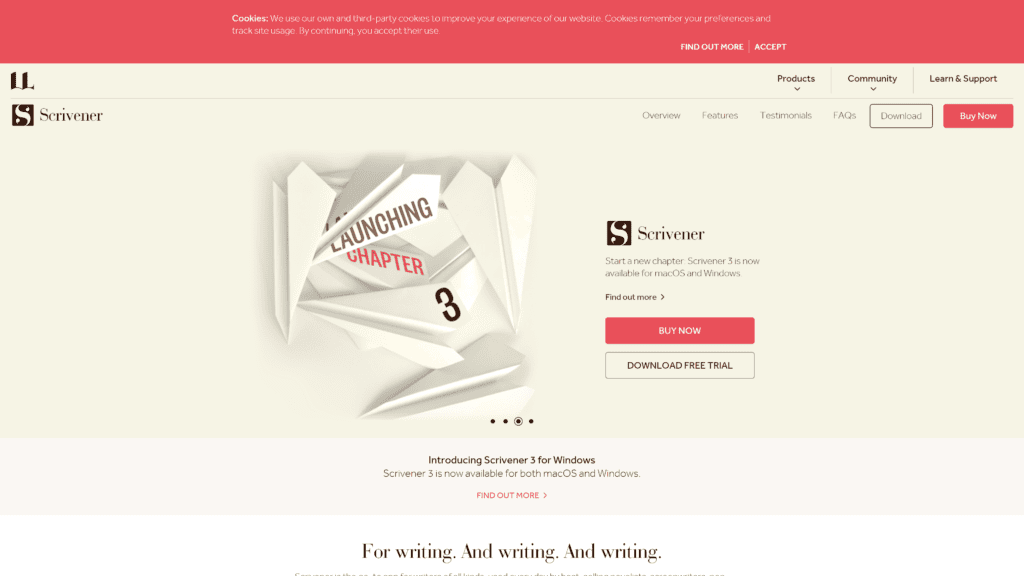
While not screenwriting software in the traditional sense (it’s primarily used for novel writing), Scrivener has a built-in script editor that warrants its inclusion on this list.
Additionally, it has many features you can use to plan and write scripts.
For one, Scrivener provides a built-in digital corkboard for organizing ideas.
The feature helps you plan your script before you start writing, ensuring you hit all the right story beats before fleshing out the first draft.
Also, each index card is tied to your script, meaning when you shuffle them around on the corkboard, the order of your script will reflect the changes.
In addition, Scrivener allows you to create templates for planning tools like character and location sheets.
Meanwhile, you can focus on writing your script, thanks to the software’s auto-formatting capabilities.
And Scrivener makes printing the finished draft straightforward, with the option to export to screenwriting software like Celtx.
Also, its easy-to-use interface will feel familiar to anyone who’s ever used a word processor.
Scrivener lets you split its editor, allowing you to place up to four documents side-by-side.
It’s a useful feature for checking consistency, as you can compare a recent scene in your script to one written earlier.
Finally, Scrivener’s fullscreen writing mode is an excellent feature for anyone who wants a distraction-free writing experience.
With one click, you can eliminate all the user interface components (menu bar, sidebar, etc.) and focus on the blank page.
Key Features
- The built-in digital corkboard helps you organize your ideas
- Template creation tools help you create planning tools like character sheets
- The editor can contain up to four side-by-side documents when split
- Scrivener’s fullscreen writing mode provides a distraction-free writing experience
Bottom Line
If you want a screenwriting tool that offers the familiarity of a standard text editor, Scrivener is worth a look.
It also helps you write other manuscripts (like novels).
Choosing Screenwriting Software – What to Look For
Choosing the best screenwriting software for your writing projects comes down to the following key considerations:
1. Automatic Formatting
Auto-formatting is one of the most crucial features to expect from screenwriting software.
This feature speeds up your writing workflow by recognizing parts of your script for what they are.
For example, auto-formatting eliminates the need to hit the tab key, instead automatically indenting dialogue after a character’s name.
In addition, this feature helps you create a screenplay that adheres to industry standards.
Instead of struggling to remember how to structure a screenplay, you can trust the AI to do the formatting for you.
2. Auto-Complete
Similarly, you’ll be hard-pressed to find screenwriting software that lacks auto-complete capabilities.
This convenient feature saves frequently-used names in a document, so you don’t have to type them out all the time.
When you type the first letter of a saved location or name, your screenwriting software should display a pop-up box containing a list of names whose first letter corresponds with the one you typed.
Being able to scroll through the list and click on the name you want will save you time and energy.
3. Automatic Saves and Syncing
If you’ve ever lost your written work to a power cut or fried computer, you’ll know how important automatic saves and syncing are
Most cloud-based writing software programs have these features as standard, and they should be high on your priority list.
Automatic backups give you the peace of mind needed to work freely, as they eliminate the need to reach for the save button every few minutes.
Meanwhile, syncing saves work done offline to the cloud once the software detects an internet connection.
4. Collaboration Tools
Solo writers may consider collaboration tools as nice-to-haves rather than core to a screenwriting software’s capabilities.
However, they’re essential if you work in a writing team.
Some screenwriting programs provide video and chat tools for quick meetings, while others let co-writers leave comments directly on your script.
Regardless, software tools with collaboration tools allow two or more writers to work on the same script simultaneously and remotely.
Wrapping Up
The best screenwriting software programs provide features that make the creative process smoother.
When choosing a screenwriting tool, ensure it has auto-complete, auto-backup, and auto-formatting functionality.
And if you’d like to get feedback on your work, it’d help if the software had collaboration features, like chat and in-line comments.





